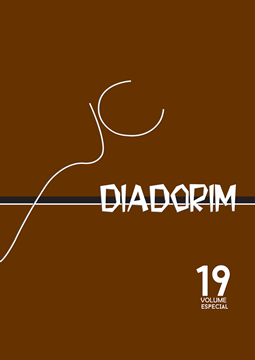Stative Morpheme In Shimakonde, An Anticausative Morpheme?
DOI:
https://doi.org/10.35520/diadorim.2017.v19n0a13610Resumo
Tis paper aims to describe the syntax of the constructions that present the verbal extensions {-ik-} and {-uk-} and their allomorphs in Shimakonde, a Bantu language classifed as P23 in the Guthrie classifcation (GUTHRIE 1967-71). Tis language is spoken in the northern regions of Mozambique and Tanzania. Tese verbal extensions are reported in literature under the labels of stative, impositive, pseudo-passive, neuter, and quasi-passive (DOKE, 1947; SATYO, 1985; MCHOMBO, 1993; DUBINSKY & SIMANGO, 1996; BENTLEY & KULEMEKA, 2001; LIPHOLA, 2001; NGUNGA, 2004; KHUMALO, 2009; LEACH, 2010; LANGA, 2013). Te addition of the {-ik-} or {-uk-} morphemes to the verb structure usually demotes or suppresses the external argument, turning a basically transitive predicate into an intransitive one. Tis paper aims to investigate in Shimakonde if alternations from a dyadic to a monadic predicate, through the use of one of the aforementioned morphemes, are instances of the phenomenon known in literature as causative/ anticausative alternation (HASPELMATH, 1987, 1993; LEVIN & RAPPAPORT HOVAV, 1992, 1995; NAVES, 1998, 2005; VAN HOUT, 2004; OLIVEIRA, 2011; KALLULLI, 2007). In order to do so, I analyze the grammatical role of this morpheme with two Shimakonde native consultants from different Mozambique districts (Mocimboa da Praia and Montepuez). Te feldwork activities consisted of translations of sentences from Portuguese to Shimakonde, testing the grammaticality of the proposed sentences. In order to examine the data that were collected, I adopted the Alexiadou, Anagnostopoulou and Schäfer (2006) refnement of the verbal categories by Levin & Rappaport Hovav (1992, 1995). One of the results obtained is that the verbal extensions display an atelic reading (giving rise to stative interpretation) or a telic reading (giving rise to anticausative or passive interpretation). To account for the different interpretations in these constructions, I propose distinct associations between Asp head and Voice head in accordance with Kratzer (1996), Pylkkänen (2002), van Hout (2004), and Oliveira (2010).Downloads
Publicado
Edição
Seção
Licença
Transferência de direitos autorais - Autorização para publicação
Caso o artigo submetido seja aprovado para publicação, já fica acordado que o autor autoriza a UFRJ a reproduzi-lo e publicá-lo na Diadorim: Revista de Estudos Linguísticos e Literários, entendendo-se os termos "reprodução" e "publicação" conforme definição respectivamente dos incisos VI e I do artigo 5° da Lei 9610/98. O artigo poderá ser acessado pela internet, a título gratuito, para consulta e reprodução de exemplar do artigo para uso próprio de quem a consulta. Essa autorização de publicação não tem limitação de tempo, ficando a UFRJ responsável pela manutenção da identificação do autor do artigo.

A Revista Diadorim utiliza uma Licença Creative Commons Atribuição-NãoComercial 4.0 Internacional (CC BY-NC 4.0).

